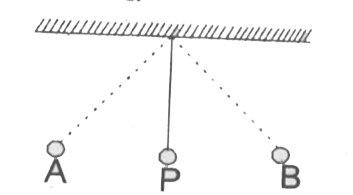Illustrate the law of conservations of energy by discussing the energy changes which occur when we draw a pendulum bob to one side and allow it to oscillate. Why does the bob eventually come to rest ? What happens to its energy eventaully ? Is it a violation of the law of conservation of energy.

The law of conservation of energy states that energy can be neither created nor destroyed. It can only be conserved from one form to another.
Consider the case of an oscillating pendulum.
When a pendulum moves from its mean position P to either of its extreme positions A or B, it rises through a height h above the mean level P. At this point, the kinetic energy of the bob changes completely into potential energy. The kinetic energy becomes zero and the bob possesses only potential energy . As it moves towards point P, its potential energy decreases progressively. Accordingly, the kinetic energy increases. As the bob reaches point P, its kinetic energy. This process is repeated as long as the pendulum oscillates.
The bob does not oscillate forever. It comes to rest because air resistance resists its motion. The pendulum loses its kinetic energy to overcome this friction and stops after same time.
The law of conservation of energy is not violated because the energy lost by the pendulum to overcome friction is gained by its surrounding. Hence, the total energy of the pendulum and the surrounding system remain conserved.
Topper's Solved these Questions
- MODEL QUESTION PAPER-2 BOOK - CPC CAMBRIDGE PUBLICATIONCHAPTER - MODEL QUESTION PAPER-2 EXERCISE - V. Answer the following Questions :
3 Videos
- MODEL QUESTION PAPER -3 BOOK - CPC CAMBRIDGE PUBLICATIONCHAPTER - MODEL QUESTION PAPER -3 EXERCISE - VI. ANSWER THE FOLLOWING QUESTION :
2 Videos
- NATURAL RESOURCES BOOK - CPC CAMBRIDGE PUBLICATIONCHAPTER - NATURAL RESOURCES EXERCISE - UNIT TEST
4 Videos
Similar Questions
Illustrate the law of conservation of energy by discussing the energy changes which occur when we draw a pendulum bob to one side and allow it to oscillate. Why does the bob eventually come to rest ? What happens to its energy eventually ? Is it a violation of the law of conservation of energy ?\
View SolutionIllustrate the law of conservation of energy by discussing the energy changes which occur when we draw a pendulum bob to one side and allow it to oscillate. Why does the bob eventually come to rest ? What happens to its energy eventually ? Is it a violation of the law of conservation of energy ?\
View SolutionIllustrate the law of conservation of energy by discussing the energy changes which occur when we draw a pendulum bob to one side and allow it to oscillate. Why does the bob eventually come to rest ?
View SolutionWhat is the law of conservation of energy?
View SolutionDoes Lenz's law violate the law of conservation of energy?
View SolutionWhat do you mean by the law of conservation of energy ?
View SolutionAn aeroplane's velocity is doubled, What happens to kinetic energy ? Is the law of conservation of energy obeyed ?
View SolutionState the law of conservation of energy. Give some examples in which this law is obeyed.
View SolutionThe kinetic energy of a freely falling ball is not conserved. Why is this not a violation of the law of conservation of energy ?
View SolutionDraw a diagram to show that the energy flow is an ecosystem is governmend by the law of conservation of energy.
View Solution
